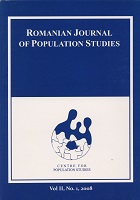Social Structures and Actors: the Application of Multilevel Analysis in Migration Research
Social Structures and Actors: the Application of Multilevel Analysis
in Migration Research
Author(s): Michael WindizioSubject(s): Social Sciences
Published by: Centrul de Studiere a Populaţiei
Keywords: internal migration; multilevel analysis; social structure
Summary/Abstract: This article gives a brief overview of multilevel modelling. Multilevel analysis is an extension of linear and generalized linear regression analysis. The article describes situations of clustered data and specifies different terms to denote multilevel methods in different sciences. Since clustered data yield an underestimation of standard errors, multilevel statistical methods should be applied if individual level observations can be assigned to higher level contexts, and if characteristics of these contexts have an impact on the outcome of interest. Moreover, it will be argued that multilevel analysis provides options of statistical model-building which go far beyond just correcting the nuisance of incorrect standard errors. In most theories and many empirical studies in the social sciences, individual actors are embedded in social contexts like regions, schools or households and context-characteristics systematically affect individual behaviour and decision making. Using an example from migration research, it will be shown how spatial context-characteristics like “distance from the border” affect internal East-West migration of labour in Germany. Finally, recent developments in multilevel modelling, like the combination with event history or network analysis,will be outlined briefly.
Journal: Romanian Journal of Population Studies
- Issue Year: 2/2008
- Issue No: 1
- Page Range: 113-138
- Page Count: 25
- Language: English
- Content File-PDF

